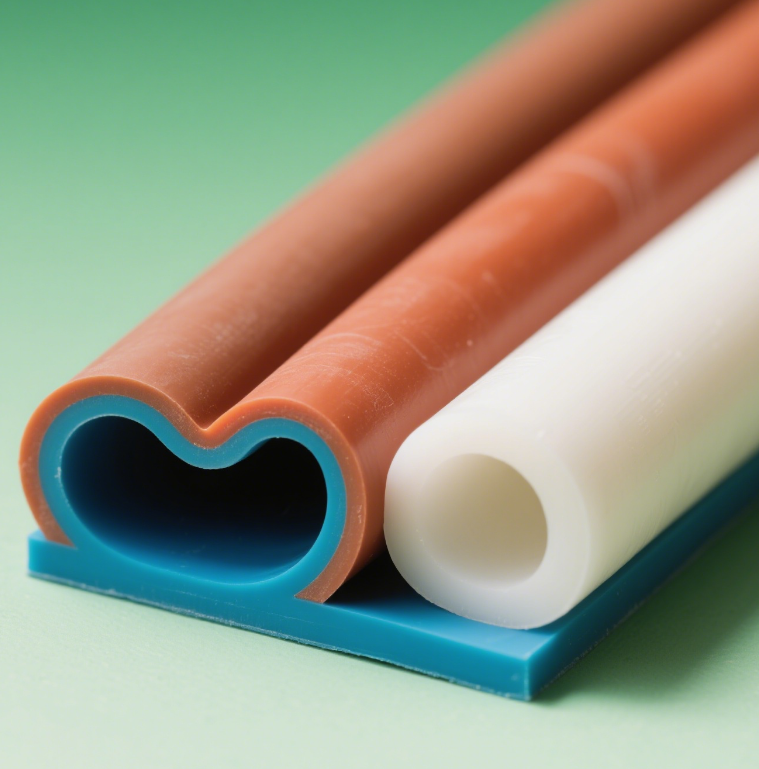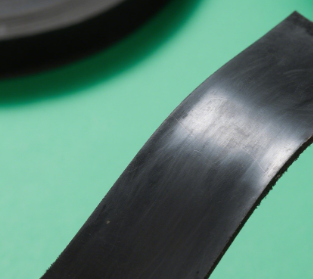Blended Products of Conductive Silicone Rubber and Non-conductive Silicone Rubber
I.Blending Principle
Conductive silicone rubber mainly obtains its conductive properties by adding conductive fillers, such as metal powders (silver powder, copper powder, etc.) and carbon-based materials (carbon black, carbon nanotubes, graphene, etc.). On the other hand, non-conductive silicone rubber is a basic silicone rubber material, which has excellent properties such as good elasticity, resistance to high and low temperatures, and aging resistance. The core principle of blending the two lies in adjusting the ratio of conductive silicone rubber to non-conductive silicone rubber, the dispersion degree of conductive fillers, etc., so as to achieve the regulation of various properties of the product, such as electrical conductivity and mechanical properties. During the blending process, the conductive fillers form a conductive network in the matrix of non-conductive silicone rubber. As the content of conductive silicone rubber increases, the conductive network gradually improves, and thus the electrical conductivity of the blended product gradually increases. At the same time, the addition of non-conductive silicone rubber can improve the processing performance and some mechanical properties of conductive silicone rubber, realizing the optimization and complementarity of properties.
II.Preparation Methods
(1) Mechanical Blending Method
The mechanical blending method is a commonly used method for preparing blended products. First, the conductive silicone rubber and non-conductive silicone rubber are put into a two-roll rubber mixer or an internal mixer in a certain proportion. During the rubber mixing process, the two rubbers are fully mixed under the action of mechanical shear force. At the same time, in order to ensure the uniform dispersion of the conductive filler in the blended system, a dispersant can be appropriately added during the blending process. The mechanical blending method is relatively simple to operate and has low requirements for equipment. However, the degree of uniform mixing may be limited to some extent, and parameters such as the mixing time and temperature need to be reasonably controlled.
(2) Solution Blending Method
In the solution blending method, the conductive silicone rubber and non-conductive silicone rubber are first dissolved in suitable solvents respectively to prepare uniform solutions. Then, the two solutions are mixed evenly, and mixing is promoted by means of stirring, ultrasonic treatment, etc. After uniform mixing, the rubber is solidified and formed by evaporating the solvent. The solution blending method can achieve uniform mixing of conductive silicone rubber and non-conductive silicone rubber at the molecular level, which is conducive to improving the dispersion of conductive fillers, so that the properties of the blended product are more uniform and stable. However, this method requires the use of a large amount of organic solvents, which brings environmental pollution and safety hazards, and the cost of solvent recovery and treatment is relatively high.
(3) Emulsion Blending Method
The emulsion blending method is suitable for silicone rubber existing in the form of an emulsion. The conductive silicone rubber emulsion and non-conductive silicone rubber emulsion are mixed in a certain proportion, and they are fully emulsified by means of stirring, etc. Then, the blended emulsion is solidified and formed through processes such as demulsification and coagulation. The emulsion blending method can achieve uniform mixing of rubber, and the mixing process is relatively mild, causing less damage to the molecular structure of rubber. However, the preparation and treatment process of the emulsion is relatively complex, and the requirements for process conditions are relatively high.
III. Performance Characteristics
(1) Adjustable Electrical Conductivity
By changing the blending ratio of conductive silicone rubber and non-conductive silicone rubber, the electrical conductivity of the blended product can be precisely adjusted. When the content of conductive silicone rubber is low, the electrical conductivity of the blended product is weak, and it can be applied to the anti-static field with low requirements for electrical conductivity. As the content of conductive silicone rubber increases, the electrical conductivity of the blended product gradually increases, which can meet the application scenarios with high requirements for electrical conductivity, such as electromagnetic shielding and electrode materials.
(2) Good Mechanical Properties
Non-conductive silicone rubber itself has excellent elasticity and mechanical properties. In the blended system, it can effectively improve the problem of the decline in mechanical properties of conductive silicone rubber caused by the addition of a large amount of conductive fillers. The blended product not only retains the high elasticity and flexibility of silicone rubber but also has a certain tensile strength and tear strength, and can maintain a good physical shape in different usage environments.
(3) Excellent Weather Resistance and Chemical Stability
Silicone rubber materials have good resistance to high and low temperatures, aging resistance, and chemical stability, and the blended product inherits these advantages. Whether in harsh environments such as high temperature, low temperature, humidity, acid, and alkali, the blended product can maintain stable performance, and it is not easy to age, deform, or suffer from chemical corrosion, which extends the service life of the product.
Application Scenarios
(1) Electronics and Electrical Appliances Field
In electronic and electrical equipment, the blended product can be used to make electromagnetic shielding materials. With the increasing miniaturization and integration of electronic devices, the problem of electromagnetic interference has become increasingly prominent. The blended product of conductive silicone rubber and non-conductive silicone rubber can effectively shield electromagnetic signals, protect the internal circuits of the equipment from interference, and at the same time prevent the electromagnetic signals generated by the equipment itself from leaking, ensuring the normal operation of the equipment and information security. In addition, the blended product can also be used to make anti-static gaskets, sealing strips, and other components to prevent static electricity from damaging electronic components.
(2) Aerospace Field
The performance requirements for materials in the aerospace field are extremely strict. Relying on its good mechanical properties, weather resistance, and electrical conductivity, the blended product can be used to make conductive seals, cable insulation sheaths, and other components on aircraft, satellites, and other equipment. In extreme space environments and high-altitude flight conditions, the blended product can work stably to ensure the safe operation of aerospace equipment.
(3) Automotive Industry Field
In the automotive industry, the blended product can be applied to automotive electronic systems, such as making the sealing protection sleeves of automotive sensors, the electromagnetic shielding components of in-vehicle communication equipment, etc. At the same time, with the development of new energy vehicles, the requirements for the safety and stability of batteries are getting higher and higher. The blended product can be used to make battery seals to prevent battery leakage and short circuits, and improve the safety and service life of batteries.
(4) Medical Field
Due to the good biocompatibility of silicone rubber materials, the blended product also has certain application prospects in the medical field. For example, it can be used to make the conductive electrodes of medical electronic devices, which not only ensures the electrical conductivity but also can make good contact with human tissues, reducing the irritation and harm to the human body. It can also be used to make medical catheters, sealing gaskets, and other components to meet the special requirements of medical equipment for material properties.
Development Trends
With the continuous progress of science and technology, the performance requirements for the blended products of conductive silicone rubber and non-conductive silicone rubber are also getting higher and higher. In the future, the blended products will develop towards high performance, multi-functionality, and intelligence. In terms of high performance, by developing new conductive fillers and optimizing the blending process, the electrical conductivity and mechanical properties of the products will be further improved. In terms of multi-functionality, more functions will be imparted to the blended products, such as self-repair and antibacterial properties. In terms of intelligence, by combining sensor technology and intelligent materials, the blended products will be able to sense and respond to environmental changes. In addition, with the enhancement of environmental protection awareness, the research and development of green and environmentally friendly blended products will also become an important development direction in the future, reducing the use of organic solvents, developing degradable silicone rubber materials, and reducing the impact on the environment.

















